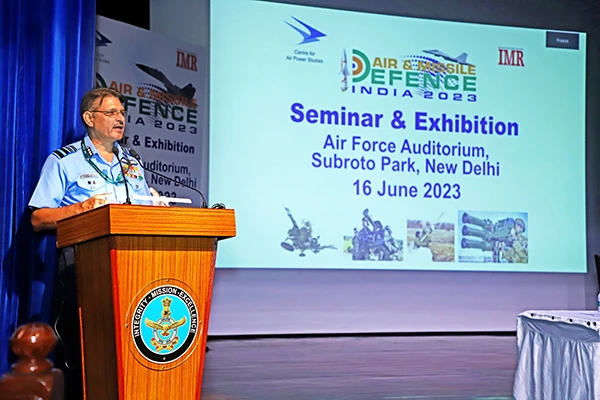Centre for Air Power Studies (CAPS) and Indian Military Review (IMR) jointly organised a seminar and exhibition – Air and Missile Defence India 2023 – on 16 June 2023 at the Air Force Auditorium, Subroto Park, New Delhi. The seminar featured distinguished speakers, including stakeholders from the armed forces, members of the scientific community, and industry dealing with India’s various air and missile defence systems. In a day of proceedings, the conference participants deliberated on new emerging air threats and consequential technology to deal with them.
Session 1 – Inaugural Session
The seminar was inaugurated by Air Marshal Surat Singh, DG Air Ops, Air HQ. The welcome remarks were given by Air Marshal Anil Chopra, Director General, CAPS. This was followed by an industry perspective provided by Col KV Kuber, Director of Defence and Aerospace, Ernst & Young. The guest speakers also released the EY-IMR knowledge paper on Air & Missile Defence.
Air Marshal Anil Chopra commenced his introductory statements by addressing the protracted conflict in Ukraine, which has persisted for sixteen months, despite the substantial casualties incurred by both opposing factions. The vulnerabilities manifest themselves through the widespread deployment of tanks, drones, large ships, cruise missiles, and aircraft, which are strategically withheld from entering technical zones due to the presence of formidable air defence systems. The concept of air Denial has been surpassed by both parties involved. Hence, the conflict has once again underscored the significance of the air and missile defence systems. Several key lessons can be derived for India from this conflict, including the imperative of maintaining unhindered supply chains and promoting domestic manufacturing. Additionally, he emphasised the significance of counter-drone technology, which encompasses various tools such as kinetic interception and electromagnetic interdiction. According to Air Marshal Chopra, India is currently developing medium and long-range surface-to-air missiles. However, there is a need to expedite the advancement of cost-effective iterations of missiles and unmanned aircraft. The speaker proposed that the private sector is making significant strides in the field, exemplified by the Kalyani missile creation. This missile was developed through a partnership between Rafael Advanced Defence Systems Ltd and DRDO, and its production involved collaboration with various players in the Indian industry, including both public and private sector entities and MSMEs. The author emphasised the government’s initiatives to promote indigenisation, encompassing both the public and commercial domains.
Air Marshal Surat Singh, DG Air Ops, Air HQ gave the Inaugural Address. He addressed the crucial capabilities of the air defence and missile system in various contexts, including times of peace, periods of uneasy peace, and even in times of war. The activation of this capability is the initial step, while its deactivation is the final action. In certain instances, it persists consistently. It offers both deterrence and the assurance needed to execute air operations. The system encompasses numerous interconnected components and sub-systems that encompass monitoring, control, and the ability to make decisions for destruction swiftly. He highlighted critical advancements in air defence during the last decade while focusing on reducing the size of systems and sub-systems and the increasing lethality of weapons and Unmanned systems, encompassing both offensive and defensive capabilities. He emphasised the evolving nature of operations, which were formerly limited to land but have since expanded into the air and are now expanding into space. He stressed the necessity of successfully encountering the threats. India’s capacity to cope with threats needs jointmanship as well as an exhaustive capability. The endeavour is to be made not in isolation but as a team. Therefore, the diverse range of threats necessitates an air defence system that can enhance capabilities and multiply abilities multiple-fold. This will entail utilising expedited, reliable, and fortified decision-making mechanisms alongside a fusion of active and passive sensors to generate a comprehensive representation. He concluded by emphasising the interaction between a user and a manufacturer during the initial stages of development of any system is crucial to the smooth transmission of situational awareness and the successful incorporation of the decision-making tool.

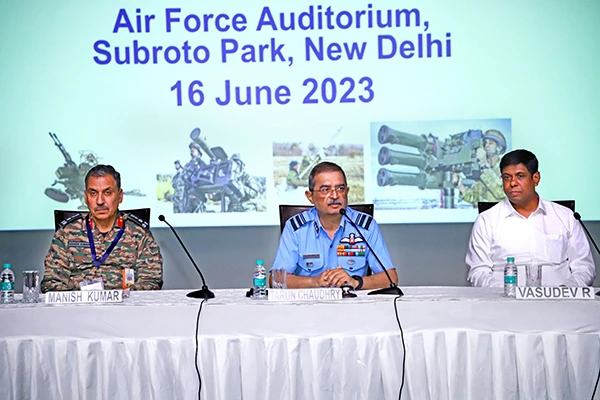
Col KV Kuber, Director of Defence and Aerospace, Ernst and Young, provided the defence industry perspective. He stated that the Indian Air Force was responsible for safeguarding the entirety of the nation’s airspace, which encompasses the island territories and offshore facilities and falls within the jurisdiction of the air defence identification zone. In order to effectively safeguard the expansive airspace, it is imperative to implement a strategy that involves the proactive positioning of surface-to-air missiles, the utilisation of countermeasures against advanced technologies, the establishment of surveillance systems and radar networks, as well as the deployment of short-range surface-to-air missiles to deter and neutralise aerial incursions. Col Kuber emphasised the significance of the heightened dissemination of quantum technologies, the integration of quantum into military operations, and the transformative impact it will have on the character of warfare. The speaker provided an explanation regarding the distinction between quantum and linear phenomena, highlighting the pervasive nature of the former in contrast to the latter. During his discourse, he also referred to the hypersonic glide vehicles. In order to effectively address the issue, it is advisable to develop an anti-missile capability that facilitates the straightforward identification of these entities. The speaker concluded his discourse by comparing the escalating military expenditures of the United States and China and subsequently deliberated on the appropriate course of action for India considering this development. In order to augment its capabilities, the government has pursued collaboration with the private sector to develop advanced weaponry. It will be stipulated to be productive.
SESSION 2 – EMERGING TECHNOLOGIES AND INDUSTRY CAPABILITIES
Session 2 was chaired by Air Vice Marshal Tarun Chaudhry, Asst Chief of Air Staff Ops (Projects), Air HQ. He emphasised technology’s importance in shaping a conflict’s contours. Therefore, it is essential for all parties involved to acknowledge and adapt to new challenges brought about by technological advancements in the context of warfare. He underlined the need to develop an appropriate industrial environment for research and development to quickly provide the essential equipment or solutions. Here, timeframe and R&D efforts are of utmost importance.
Gp Capt Prashant Arora, Air HQ, discussed the ‘Lessons in AD from the Russia-Ukraine War.’ As part of the philosophies/concept of operations, he highlighted the DEAD/SEAD missions conducted by the Russian Aerospace Forces (VKS), which allowed the Ukrainians to mount an effective air defence response. Russian forces employed Kh-31 and Kh-58 ARMs extensively against Ukrainian ground-based air defence weapons. The Ukrainians also utilised customised MiG-29s equipped with AGM-88 HARM with success.
The Ukrainian PSU’s innovative and flexible air defence systems have prevented the Russian VKS from dominating the sky. Russia’s VKS employed the S-400 in Belarus and Crimea to illustrate its practical air defence doctrine. The surface-to-air missile system of the S-400 was effective at bringing down aircraft. Russian aircraft were forced to fly at low altitudes due to the Ukrainians’ effective use of the S-300 SAM and SA-11. The Pechora system was an effective anti-aircraft armament for the Ukrainians. As part of the anti-missile/SOWs operation, it is impossible to intercept Russian Tochka-U and Iskander missiles due to a lack of adequate interceptor missiles. Between 80% and 90% of Ukrainian missiles were intercepted by the Russian S-400. Intercepting Russian “Zircon,” “Vanguard,” and “DF-ZF” hypersonic cruise missiles during anti-hypersonic operations is complex. He stated that the Russian VKS Integrated Air Defence System (IADS) had little effect on the efficacy of the air defence network. Active AD capability and passive AD measures against missiles/ SOWs/ HCMs/HGVs are essential for assuring survivability. AWACS and AEW&C are crucial enablers for AD Operations. The development of future AD capabilities must be prioritised, and plans must account for detecting and eliminating low RCS threats.
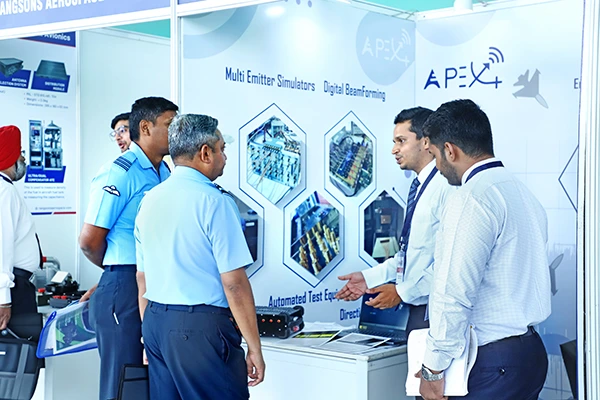
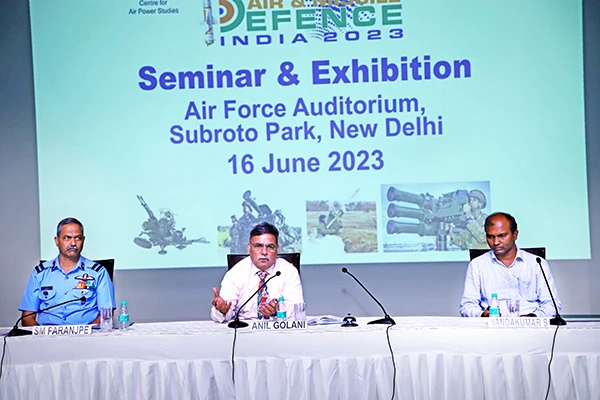
Brig Manish Kumar, Brig AAD Ops, Army HQ, discussed the ‘Emerging Air Threat: Challenges to Ground Based Air Defence Weapon Systems (GBADWS) from Recent Conflicts.’ He addressed the concept of air threat in its state of being and air threat in its manifestation. Air threats encompass various factors, including numerical strength, quantity, aircraft types, capabilities, operational ranges, refuelling capabilities, and tactical approaches. “Air Threat Manifestation” refers to the strategic process of developing and implementing measures to mitigate air defence risks. The manifestation of air threats necessitates the management of stand-off threats, limited stand-off threats, and dynamic threats. He emphasised the increase in the variety of air attack instruments and the expansion of the range of potential threats, including remotely piloted aircraft systems (RPAs) and unmanned aerial systems (UAS). Additionally, they mentioned the emergence of futuristic air threats such as hypersonic and hyper glide technologies, as well as surface-to-surface missiles (SSMs) and ballistic missiles. Furthermore, they noted the resurgence of conventional dumb bombs, explicitly referring to rocket-boosted kinetic energy (REK) weapons and gliding munitions. According to Brig Manish Kumar the VKS air operation in Russia is limited to the Central Military District (CSFO) and activities related to air defence. The initial chapter operations yielded successful outcomes. The initial attacks were limited to Stand Off Launches utilising Kh series Cruise Missiles and ARMs. However, they were effectively countered by the Ukrainian S-300 air defence systems. Moreover, the SHAHED-136 introduction was employed in Ukraine. The term “three-layer air defence” is a misnomer. Each layer must be designed to address a specific type of threat. To address various levels of threat, encompassing stand-off threat, limited stand-off threat, and dynamic threat, it becomes imperative to implement a comprehensive array of mitigation measures. He identified the prerequisites for comprehensive air defence solutions, which include low radar cross-section (RCS) surveillance, low-level surveillance, and stealth surveillance. The layout challenges faced by the defence industry encompass several key aspects, including the miniaturisation of components, the management of electromagnetic interference and electromagnetic compatibility in limited spaces, the ability to handle multiple targets simultaneously, and the development of cost-effective electronic identification friend or foe (IFF) solutions.
Sh Vasudev Ramakrishna, Scientist F, LRDE, DRDO, discussed the ‘New Developments in Radars for Detection, Tracking Threats and Targeting.’ He deliberated on radars concerning air and ballistic missile defence. Modern radar systems possess various applications, encompassing areas such as ballistic missile defence, air defence, weapon designation, reconnaissance, commercial utilisation, weather monitoring, and interplanetary investigations. The radar may be categorised as surveillance radars, which possess a mechanical rotation fixed RPM, offer volumetric search capabilities, have fixed target update intervals, and exhibit limited range and angular resolution as well as accuracies; track radars, designed for tracking a single target, have limited search capabilities; and multiple radars for diverse threats, which are specialised in their respective functions and have limited programmability. To construct a unified multifunction radar system in the future, it will be necessary to address various components of radar sub-systems, including waveform agility (such as low pulse repetition frequency and medium pulse repetition frequency, as well as target radar cross-section estimation), as well as the programmability of radar modes (such as air defence and ballistic missile defence).
SESSION 3 – EMERGING THREATS, SURVEILLANCE AND DETECTION
Air Vice Marshal Anil Golani, Additional Director General, Centre for Air Power Studies, chaired session 3. He emphasised the importance of hypersonic weapons and the difficulties faced by current countermeasures in addressing them. In contrast to ballistic missiles that can be easily intercepted and monitored, identifying hypersonic missiles poses a significant challenge. To effectively tackle these challenges, it is imperative to embrace technological advancements.
Air Commodore SM Paranjpe, Team Ldr, Project AD Services Interface Gp, Air HQ addressed the challenges associated with ballistic and hypersonic missiles, as well as stand-off weapons. He gave an account of the historical background of hypersonics, with particular emphasis on ‘The Great Extinction Event’ that occurred approximately 66 million years ago, resulting in the extinction of all dinosaur species. It also emphasised the historical, contemporary, and prospective dimensions of hypersonic weaponry; and furnished an extensive account of the fundamental principles underlying hypersonic velocities, elucidating various attributes of hypersonics, ultrasonics, supersonics, and related phenomena. He elucidated the distinct challenges associated with stand-off weapons by examining the ballistic trajectory and orbital trajectory within the classification of ballistic armaments. He discussed the tactical obstacles associated with air defence, specifically focusing on four key aspects: being situated beyond the radar horizon and at a low altitude, operating at high altitudes and speeds, flying at low altitudes and high speeds, and possessing small or stealthy characteristics. He gave insight into the origins of the challenges, specifically highlighting the Anti-Hypersonic Weapons Technology Challenge and the requisite scientific expertise. He concluded by directing attention towards the main points to be learned and the actions being implemented to address them, categorising them into three distinct areas: Technology, Organisation, and Operations.
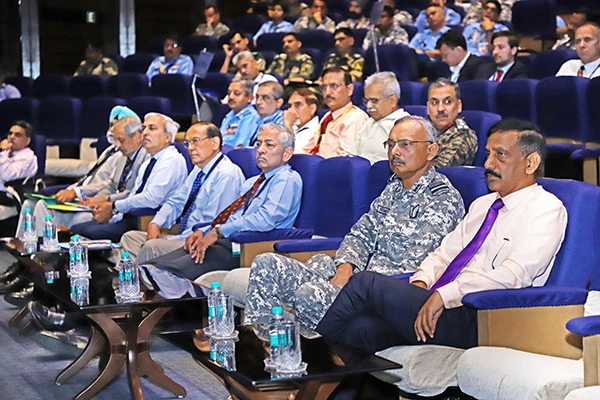
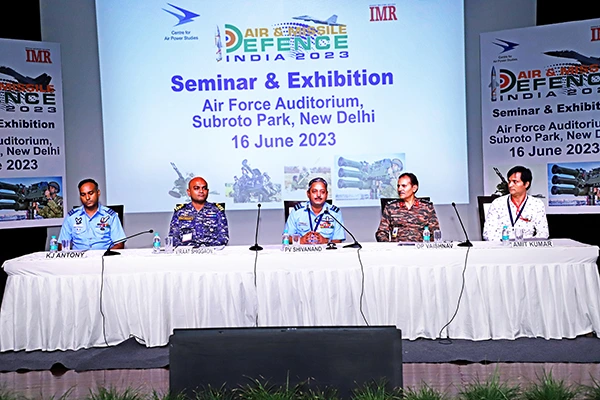
Sh Nandakumar S, Scientist F, LRDE, DRDO, gave an insight into ‘the OTH Radar for Peninsular & Chinese Front: a Perspective.’ Considering that OTH Radars operate at high frequencies, he emphasised their value. He compared the two Over Horizon (OTH) Radars, such as the Surface Wave OTH (SW OTH) and the Sky Wave OTH (SKW OTH). He emphasised the examination of OTH Radar, specifically highlighting various countries such as Iran, the United Kingdom, the United States, Romania, and Israel and the respective radar systems they possess. He presented an analysis of a separate survey pertaining to the Skywave Over-The-Horizon (OTH) Radar, specifically focusing on the United States. He emphasised the various sub-systems of the SkW OTH Radar, including transmitters, receivers, and Tx Antennas, as well as the techniques and technologies employed within these sub-systems. According to the research conducted by Sh Nandakumar S, developing a Skywave Over-the-Horizon Radar (SkW OTHR) for specifically identified locations is feasible. He emphasised the development of Ionosphere modelling is imperative for SkW OTHR. He proposed that the implementation of the Frequency Management System should be completed within a time-frame of approximately five years. He discussed the advancement of the Surface Wave Over-the-Horizon Radar (OTHR) for the Indian Navy, specifically in the Gujarat Peninsula, which is nearing completion. It is anticipated that the radar system will become operational within a year. Additionally, Nandakumar highlighted the forthcoming development of the Two-L shape (180* Coverage) SkW OTHR for Sea/Air Surveillance, which is expected to be completed within a time-frame of 5-7 years. This technological advancement is anticipated to provide the Indian Armed Forces with enhanced capabilities to assess the Chinese front.
SESSION 4 – AIR DEFENCE COUNTERMEASURES
Air Vice Marshal PV Shivanand, Asst Chief of Air Staff (Air Defence), Air HQ chaired the session. He highlighted that conventional air defence was designed to detect certain airborne flight objects. In recent times, there have been changes in the basic detection capability; and multiple new threats challenge the domain of air defence. We need to address it on priority.
Wg Cdr KJ Antony, Joint Director AD, Air HQ, presented his views on ‘Countering Stealthy Aerial Threats.’ His presentation centred around four fundamental domains pertaining to the attainment of stealth capabilities. These domains encompassed the concept of stealthy aerial threats, their potential ramifications on air operations, as well as the strategies employed to counteract such threats, encompassing both existing and future technologies. He perceived stealth as a fusion of technological elements aimed at evading or prolonging the process of detection. For example, stealth aircraft must possess minimal signatures across various electromagnetic (EM) spectrum domains, including radar, infrared, acoustics, and visual signature. In order to attain stealth capabilities in a fighter aircraft, it is imperative to strike a delicate equilibrium between the attributes of stealth, manoeuvrability, and cost-effectiveness. The individual emphasised that achieving stealth or low observability can be accomplished by reducing radar cross-section, minimising infrared signature, and diminishing visual signature. He classified stealthy aerial threats into three categories: airborne platforms that employ stealth technology, threats with low radar cross-section (RCS) or low observability, and threats that do not require line-of-sight (LOS) engagement, such as terrain-hugging missiles and ballistic missiles. In order to address the challenge posed by covert airborne threats, the individual in question proposed the implementation of an anti-stealth system capable of functioning autonomously or in conjunction with other systems. This system would utilise multiple sensors to generate a comprehensive air situation depiction, thereby enhancing the likelihood of successful detection. Ultimately, he emphasised the importance of space-based systems to mitigate the risks posed by stealth aerial threats in forthcoming times.
Cdr Viraat Shiggaon, Cdr Staff Requirements, Naval HQ, explained the ‘AD Countermeasures: Naval Perspective.’ He focused on the growing dangers in the maritime sphere and the accompanying advances in AD technology of the future. While marine air defence (AD) is generally comparable to other services, the sea presents unique obstacles. Cooperative engagement is made possible by both long- and medium-range SAMs. The evolution of modern air defence weaponry is motivated by the changing geopolitical landscape. It serves as an anti-access/area-denial mechanism. Since its final velocity is so incredible, it cannot be stopped by traditional AD systems. The use of decoys and MIRVs increases the difficulty of engagement. The topic of the operations of unmanned vehicles and swarm drones was discussed. It is a low-priced A2/AD weapon that regular armies and insurgents can deploy. He discussed potential future technologies for naval air defence, focusing on “the electromagnetic railgun,” which is affordable and can engage supersonic targets at extended ranges; “laser/microwave weapons,” which can engage hypersonic weapons/anti-drone systems; and “anti-ship ballistic missile (ASBM) interceptors,” which can engage ASBMs during both the boost and re-entry phases. He ended by stressing the importance of indigenisation, the introduction of cutting-edge technology and innovations, and the creation of counter-technologies.
Brig. OP Vaishnav, AAD Dte, Army HQ explained ‘Countering Unmanned Aerial Threats – Future Roadmap.’ He focused on how the aerial danger posed by Unmanned Aircraft Systems (UAS) has changed over time. UAS include anything from tiny quad/hexa copters to huge fixed-wing military UAVs. There are three levels of threat – superficial, intermediate, and severe. He pointed out that India’s rivals on both sides can now produce and build unmanned aerial systems on their own. The Burraq, Barq LGB, Wingloong-10, CH-4, Shahpar-2, and Sharp Sword are among the dangerous autonomous weapon systems they want to modernise with. Surveillance, identification, and tracking; microprocessors or calculating a firing solution; and interdiction were the three pillars he emphasised under the Counter UAS system pillars.
Sh Amit Kumar, Scientist F, PGAD, DRDO, presented his views on ‘Countering the Threat from Ballistic and Hypersonic Missiles and Stand-off Weapons.’ The increased range and precision of ballistic missiles, their potential use by non-state actors, and the diffusion of ballistic missile technology were all issues he brought up, as was the danger posed by ballistic missiles in the Indian subcontinent, he said. India needs a ballistic missile defence system because of its no-first-use (NFU) nuclear strategy. Ballistic, subsonic, and supersonic cruise missiles are the current go-to options for delivering warheads across vast distances. Using hypersonic glide vehicles, hypersonic cruise missiles, and MARVs by adversaries is a common strategy for countering and penetrating missile defences. An emerging danger is the hypersonic glide vehicle. Low altitude gliding, high manoeuvrability, re-targeting area, and high cross-range capability to plan the glide path allow it to penetrate enemy ballistic missile defence while engaging time-critical targets like ballistic missile launch pas/silo, deeply buried command centres, air bases, warships, and tactical targets.
Air Marshal Anil Chopra (Retd), Director General, CAPS, delivered his closing remarks at the conclusion of the ideation sessions. Air Marshal Chopra commended the astute presentations and notable presence of all panellists, as well as the intellectually stimulating questions posed by the audience.
The seminar ended with a Vote of Thanks by Maj Gen Ravi Arora, Chief Editor Indian Military Review.


